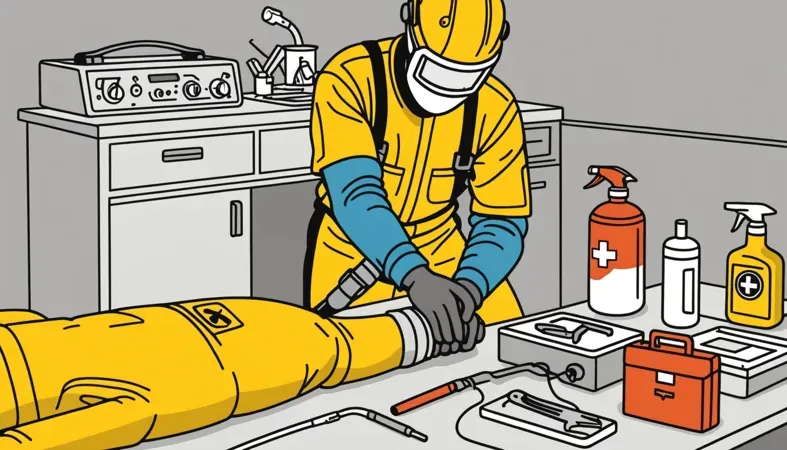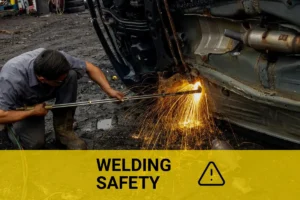What to Do for Welding Burns on Skin? Treatment, Prevention, Aftercare
Published on: April 9, 2025 | Last modified: March 4, 2025
By: Joe Carter
Burns are injuries caused by heat, chemicals, or electricity. They can damage your skin and sometimes, deeper layers too.
It’s a question I’ve heard often: what to do for welding burns on skin? Knowing how to treat these burns is crucial because improper care can lead to infection or scarring. I’ve seen it happen, and trust me, it’s best to tackle burns right away to promote healing and reduce pain.
In this guide, we’ll cover how to treat welding burns efficiently, identify different types of burns, outline the steps to treat them, discuss factors influencing treatment, highlight common issues you might face, recommend aftercare tips, explore alternative treatments, and answer frequently asked questions. You’ll learn how to treat welding burns on skin and even what to put on burns from welding. Having this knowledge can save your skin in more ways than one!
Contents
- What Should You Do for Welding Burns on Skin?
- How Do You Treat Welding Burns on Skin?
- Types Of Welding Burns
- Steps to Treat Welding Burns
- Factors Influencing Treatment for Welding Burns
- Common Issues With Welding Burns
- Aftercare, Inspection, and Advanced Tips for Welding Burns
- Applications Of Welding Burn Treatment
- Alternatives for Treating Welding Burns
- Frequently Asked Questions (FAQs)
- Conclusion
- References
What Should You Do for Welding Burns on Skin?
For skin burns from welding, cool the area with running water for 10-20 minutes. Apply aloe vera or antibiotic ointment to promote healing. This method works best for minor burns and speeds up recovery.
Welders should be aware of the potential health risks associated with their occupation including the risk of cancer from prolonged exposure. Read more about how welding can cause cancer to stay informed.
How Do You Treat Welding Burns on Skin?
Welding burns are injuries caused by high heat or molten metal from welding processes. They fall into three categories: first-degree, second-degree, and third-degree burns. First-degree burns affect only the outer layer of skin and cause redness. Second-degree burns involve deeper layers with blisters, while third-degree burns damage all skin layers and may affect underlying tissues. Statistics show that 38% of workplace burns occur due to welding activities. For more information on treatment of burns, see the Johns Hopkins Medicine site.
To treat welding burns effectively, assess the burn type first. Cooling the burn and reducing heat exposure can minimize damage. Apply specific ointments to promote healing and prevent infection.
I once ignored a small welding burn on my arm. It seemed minor but turned into a painful second-degree burn that took weeks to heal. Trust me, don’t underestimate proper treatment methods for welding burns—they can include how to treat burns on arms or what to apply to a welding burn to maintain skin integrity and comfort.
Types Of Welding Burns
What types of burns can you get from welding?
-
First-degree Burns
First-degree burns affect only the outer layer of skin. Rinse the burn with cool water. Apply aloe vera gel or a burn ointment, like Neosporin, and cover it with a non-stick bandage.
-
Second-degree Burns
Second-degree burns penetrate deeper, affecting both the outer and underlying skin layers. Cool the burn with running water for at least 10 minutes. Use a sterile dressing and avoid popping blisters.
-
Third-degree Burns
Third-degree burns damage all skin layers and may affect muscle. Seek medical attention immediately instead of treating it at home. Keep the area clean and cover it with a sterile cloth.
-
Electrical Burns
Electrical burns result from currents passing through the skin. Get emergency medical help right away due to potential internal damage. Do not attempt to treat it yourself.
-
Chemical Burns
Chemical burns occur when skin contacts harmful substances. Rinse the affected area with cool, running water for at least 20 minutes. Remove contaminated clothing and seek medical advice.
We’ve wrapped up the different types of welding burns here. Next up, we’ll look at how to treat them.
Steps to Treat Welding Burns
Here are the steps to follow when treating welding burns.
-
Stop the Welding Process
First, immediately stop all welding activities. This prevents further injury and allows you to focus on treatment. Don’t let adrenaline keep you going; injuries need attention right away. Every second counts with burns! For specific steps and best practices on handling welding-related incidents, refer to the welding guidance available on the site.
It’s also crucial to consider the risks posed by inhaling toxic fumes during welding processes. For those looking to safeguard their respiratory health while working, understanding how to prevent inhaling welding fumes is essential.
-
Assess the Burn Severity
Evaluate the burn’s severity. A first-degree burn affects only the outer layer of skin and appears red or swollen. A second-degree burn blisters and is more painful. If the skin looks white or leathery, it’s a third-degree burn, and you should seek immediate medical attention.
-
Clean the Affected Area
Gently rinse the burn with cool running water for about 10-15 minutes. This reduces heat and swelling. Avoid using too much pressure, as it can increase pain. Don’t use ice, as it can further damage the skin. If dirt is present, gently clean it with mild soap, avoiding scrubbing.
-
Apply Burn Ointment
Choose a burn ointment that contains lidocaine or aloe vera. These ingredients provide relief and promote healing. Apply a thin layer over the clean, dry burn, and don’t use too much, as overapplication can trap moisture and increase infection risk.
-
Cover the Burn
Use a sterile, non-stick bandage to cover the burn. Keeping it clean prevents infection. Change the dressing daily or if it gets wet or dirty. Monitor it for increased redness or pus, which can indicate infection.
-
Seek Medical Attention if Necessary
If the burn is larger than 3 inches (7.5 Cm) or shows signs of infection, consult a professional immediately. Full-thickness burns usually require advanced medical care. Burns on the face or sensitive areas also need prompt evaluation. Always err on the side of caution with skin injuries!
So far we covered the steps to treat welding burns. Next, let’s look at the factors influencing treatment for welding burns.

Factors Influencing Treatment for Welding Burns
What factors affect your response to welding burns on the skin?
-
Burn Severity
The severity of a burn directly impacts treatment options. Minor burns may heal in days, while severe burns (2nd to 3rd Degree) may require extensive medical intervention and take weeks to recover.
-
Area Affected
Burns on sensitive areas, like the face, need careful attention. Treating facial burns often involves specialized products to avoid scarring and promote effective healing.
-
Type Of Weld Used
Different welding methods produce varying burn risks. I once made the mistake of using gas welding without proper gear, resulting in deeper burns than expected due to heat concentration. Understanding the type of burn—thermal, chemical, or electrical—guides treatment.
-
Duration Of Exposure
The longer your skin’s exposed to heat, the worse the burn. Just 1 second of contact with molten metal can cause serious burns, while continuous exposure can be life-threatening.
-
Individual Skin Sensitivity
Your skin type matters. Some people may heal faster, while others experience prolonged irritation and heavier scarring, often linked to sensitivity or pre-existing conditions.
We covered factors affecting welding burn treatment, including severity and location. Next, we will cover common issues related to welding burns.
Common Issues With Welding Burns
Let’s look at some common problems that arise with welding burns.
-
Infection Risk
Welding burns can easily get infected. Watch for pus or increased redness. To treat it, clean the area with hydrogen peroxide and apply an antibiotic ointment.
-
Scarring
Welding burns may scar if not treated properly. I once ignored care, and now I have a mark. Use silicone gel or ointments to reduce scarring.
-
Delayed Healing
Welding burns can take longer to heal depending on their severity. If there’s no improvement after a week, consult a doctor. Keep the burn clean and moist to promote healing.
-
Allergic Reactions
Welding burns might trigger allergies. Watch for swelling or rashes. Treatment may include antihistamines or topical creams to soothe irritation.
-
Persistent Pain
Pain from welding burns can linger if untreated. If pain increases or persists, consider NSAIDs (Nonsteroidal Anti-inflammatory Drugs) like ibuprofen. Seek medical help if it worsens.
Aftercare, Inspection, and Advanced Tips for Welding Burns
Here’s specialized advice for handling welding burns effectively.
Aftercare Tips
After treating burns, keep the area clean. Use saline solution (0.9% Saline) to rinse the burned skin. Apply a non-stick dressing, like Primapore, and change it daily or if it gets soiled to promote healing.
Inspection
Inspect the burn for any signs of infection, such as pus or increased redness. Check the depth; deeper second-degree burns may need advanced care. Use products like Betadine for initial cleansing. I’ve relied on Bacitracin to prevent infections.
Expert Tips
If you’re experienced, consider using a hydrogel dressing (For Burn Relief) to maintain moisture in the wound. Monitor for changes every 6 hours and adjust bandages as needed. To prevent scarring, silicone sheets can reduce hypertrophic scars, starting application as soon as the wound is closed.
Applications Of Welding Burn Treatment
I’ve found several practical solutions for treating welding burns on skin. Here are a few specific applications:
- Cooling Gel: Provides immediate relief after burns. It cools and soothes, offering quick pain relief. It’s quite popular on job sites.
- Hydrogel Dressings: Ideal for second-degree burns, these dressings maintain moisture and promote healing. They’re gaining popularity in welding environments.
- Silver Sulfadiazine Cream: Used for infections or severe burns while accelerating healing. It’s widely recognized by first aid responders.
- Aloe Vera Gel: Natural and soothing, perfect for minor burns. It’s a go-to for many welders due to its skin-healing properties.

Alternatives for Treating Welding Burns
There are options that can achieve similar results as classic treatments for welding burns. Over-the-counter cream like Neosporin can speed up healing, while Hydrogel products, such as InstaFresh, provide a cooling effect to relieve pain. For deeper burns, silicone gel sheets, like ScarAway, might help by hydrating the skin and reducing scarring. Using proper protective equipment such as a well-adjusted welding helmet is crucial in preventing such injuries. To ensure optimal protection, learn the steps for adjusting your welding helmet.
Some folks prefer natural remedies. Aloe vera, known for its soothing properties, can be applied directly to the burn. Additionally, honey’s natural antibacterial traits make it an excellent choice for treating minor welding burns, promoting healing effectively. Choosing the right materials is crucial for effective welding work which includes understanding electrode classifications like E316-16.
Frequently Asked Questions (FAQs)
Now let us look at some questions I typically get asked.
How Do You Prevent Welding Burns?
To prevent welding burns, you should always wear proper personal protective equipment (PPE). This includes flame-resistant clothing, gloves, and a welding helmet. According to the American Welding Society, using the right gear can significantly enhance your compliance with welding safety precautions, reducing burn incidents by up to 80%.
When discussing eye protection, it’s intriguing to consider whether one can view an eclipse through a welding mask.
.
How to Treat Welding Burns on Arms?
To treat welding burns on arms, cool the burn with running water for at least 10 minutes. This helps reduce pain and prevent further damage. After cooling, cover the area with a clean, dry dressing to prevent infection. Understanding various welding techniques is crucial for safety and efficiency; enhance your knowledge about submerged arc welding methods.
How to Treat a Welding Slag Burn?
To treat a welding slag burn, first, remove any debris from the burn area. Then cool it with water for 10-20 minutes. Slag can cause severe damage, so quick treatment reduces the risk of complications. When engaging with welding projects, selecting the right welding gas is crucial to ensure optimal results. Discovering where you can purchase welding gas online can streamline your preparation process and enhance your safety measures. For more information, please check on where to acquire welding gas.
What to Put on a Welding Burn?
To treat a welding burn, apply an antibiotic ointment and cover it with a sterile bandage. This protects the burn and helps heal the skin. Keeping the area clean and covered speeds up recovery.
When welding on a vehicle, it’s crucial to ensure safety by knowing what components to disconnect.
How to Treat Welding Burn on Face?
To treat a welding burn on the face, cool the burn with running water for at least 20 minutes. Burns on the face are sensitive, so you may want to use a moist, cool cloth. Seek medical help if the burn is severe or blisters appear.
Conclusion
Phew, that’s a lot to digest. We covered how to treat welding burns, the types of burns you might encounter, the steps to take for proper treatment, and factors that can affect healing. We also discussed common issues with welding burns, essential aftercare, and some alternative treatments you can consider.
I trust these insights have been helpful in answering what to do for welding burns on skin. Remember, treating welding burns involves quick first aid, like cooling the burn with running water for at least 10 minutes. Then you can apply a burn ointment, keep the area clean, and let it heal while monitoring for any signs of infection.
To further enhance your knowledge about welding practices, feel free to explore more tips at What is Welding.
References
- American Welding Society. (2020). AWS Welding Handbook: Welding Science and Technology (Vol. 1). Miami, FL: AWS.
- American Welding Society. (2020). AWS C5.6: Recommended Practices for Gas Metal Arc Welding. Miami, FL: AWS.
- Miller Electric. (2021). Welding Safety: A Complete Guide. Appleton, WI: Miller Electric Manufacturing Company.
Joe Carter is a retired welding professional with over 40 years of hands-on experience in the industry, spanning ship repair, structural welding, and even underwater projects. Joe is a master of MIG, TIG, and Stick welding. Passionate about mentoring the next generation of welders, Joe now shares his decades of expertise and practical insights to help others build rewarding careers in welding.
American Welding Society, Burn Treatment, First Aid, Metalworking, Personal Protective Equipment, Safety Precautions, Skin Injuries, Welding, Welding Burns, Welding Safety, Welding Techniques







